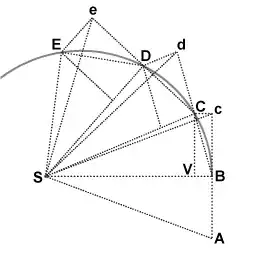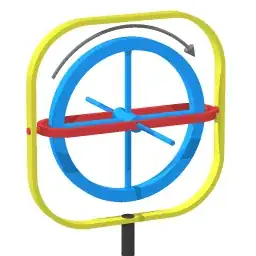With all due respect to W.Lewin, maybe not the clearest point of his series of lectures. IMHO in classical mechanics there's no need to introduce these "extra" definitions, that generate confusions:
- what he calls spin angular momentum can be simply defined as "angular momentum w.r.t. the center of mass, $G$"
- what he calls orbital angular momentum can be simply defined as "the difference of the angular momentum w.r.t. a point $H$ and the angular momentum w.r.t. $G$"
Since you're a high-school student and maybe not that much familiar with integrals, I'm using here a system of discrete points, to replace integrals with summation. But, as you're preparing for the Olympiads, I'm using summations and vectors.
The answer is split in few sections: (1) angular momentum for generic systems of point masses; (2) angular momentum for rigid systems of point masses; (3) angular momentum for rigid systems of point masses, performing rotation w.r.t. a constant direction; (4) answers to your questions.
Angular momentum for generic systems of point masses
Angular momentum of a system of point masses $P_i$ w.r.t. a generic point $H$ ("geometric point", that has nothing to do in general with the system you're studying) is defined as
$$\vec{L}_H = \sum_i m_i (P_i - H) \times \vec{v}_i \ ,$$
The vector connecting the pole $H$ to the point $P_i$ of the system can be then written as the sum of two vectors,
$$(P_i - H) = (P_i - C) + (C - H) \ ,$$
where $C$ can be chosen to be one particular point of the system, either a material point or a point that can be calculated as a function of the properties of the system (e.g. masses $m_i$ and points $P_i$). As an example, $C$ can be chosen to be the center of mass $G = \frac{1}{\sum_i m_i} \sum_{i} m_i P_i$.
The angular momentum can now be written as
$$\vec{L}_H = \sum_i m_i (C-H) \times \vec{v}_i + \sum_i m_i (P_i-C) \times \vec{v}_i \ ,$$
having split the angular momentum as the sum of a contribution that depends on the position of the pole $H$, and the a contribution - the second one - that doesn't depend on the position of $H$. Choosing $C \equiv G$, we get exactly the two definitions of the contributions to the angular momentum of a system w.r.t. a generic point $H$ provided at the beginning of this answer. In the first contribution, as $C$ and $H$ don't depend on the summation index $i$ they can be brought outside the summation, that reduces to the momentum of the system,
$$\sum_i m_i \vec{v}_i = m \vec{v}_G = \vec{Q} \ ,$$
and the angular momentum can be thus written as
$$\vec{L}_H = (C-H) \times m \vec{v}_G + \sum_i m_i (P_i-C) \times \vec{v}_i \ ,$$
which ultimately leads to the beautiful result
$$\vec{L}_H = (C-H) \times m \vec{v}_G + \vec{L}_C $$
Angular momentum for rigid systems of point masses
The velocity of two points $A$, $B$ of a rigid system are related to their relative positions $(B-A)$ and the angular velocity of the system $\vec{\omega}$,
$$\vec{v}_B - \vec{v}_A = \vec{\omega} \times (B - A) \ .$$
The center of mass of a rigid system is a material point, and thus it's possible to write the velocity $\vec{v}_i$ of any point $P_i$ as
$$\vec{v}_i - \vec{v}_G = \vec{\omega} \times ( P_i - G ) \ .$$
Thus the angular momentum of a rigid system can be written as
$$\vec{L}_H = (G-H) \times m \vec{v}_G + \sum_i m_i (P_i-G) \times (\vec{v}_G - (P_i - G) \times \vec{\omega}) \ .$$
The first term of the summation is identically zero since
$$\sum_i m_i (P_i-G) \times \vec{v}_G = \vec{v}_G \sum_i m_i (P_i-G) = \vec{v}_G \, m \, (G - G) = \vec{0} \ .$$
The second term can be written exploiting the definition of the (tensor of, in general 3-dimensional probles) inertia w.r.t. the center of mass
$$\mathbb{I}_G := - \sum_{i} (P_i - G)_{\times} (P_i - G)_{\times} \ ,$$
as $\mathbb{I}_G \cdot \vec{\omega} \ .$ Thus, even if you're not familiar with this notation - but you trust me at least for few lines, before approaching the next section with the simplifcations required to get the formula you may be familiar with - it's possible to write the angular momentum - as before - as the sum of two contributions, (1) one depending on $H$, and the velocity of the center of mass $\vec{v}_G$, i.e. the translation of the center of mass; (2) one not depending on $H$, nor on the velocity of the center of mass $\vec{v}_G$, but only on the angular velocity of the system, and that can be written as a "product of inertia w.r.t. $G$ and angular velocity",
$$\vec{L}_H = (G-H) \times m \vec{v}_G + \mathbb{I}_G \cdot \vec{\omega} \ .$$
Angular momentum for rigid systems of point masses, performing rotation w.r.t. a constant direction
Focusing only on rotations w.r.t. a constant direction (here called $\hat{z}$, the direction pointing outwards from the screen of your device, as an example), this term usually reduces to $I_G \omega \hat{z}$,
$$\begin{aligned}
\vec{L}_H = (G-H) \times m \vec{v}_G + I_G \omega \hat{z} \ . && (1) \end{aligned}$$
Answer your questions
- He stated that the spin angular momentum must only be taken about the COM. But what if the body is rotating about a fixed axis which is not the COM, what about that case.
If we don't introduce extra definitions and just rely on the last expression of the angular momentum, what W.Lewin calls sping angular momentum is just $I_G \omega \hat{z}$. So "spin angular momentum must...about the COM" really translates in "I call $I_G \omega \hat{z}$ the spin angular momentum, as the first contribution is identically zero, if I choose $G$ as the pole, $H \equiv G$).
If you want to evaluate the angular momentum w.r.t. a point $H$ that is not coincident with the center of mass, you need also the first contribution, "the orbital angular momentum" $(G-H) \times m \vec{v}_G$
- Can we say there are 2 angular momentum 'components' (spin and orbital) for a rolling body (in pure rolling) about some chosen origin (which isn't the COM), I_com * w and mrv_com?
Whatever the chosen pole $H$, the motion of a rigid body can be described as the combination of the translation of one of its points $P$ and a rotation. Angular velocity is a dynamical quantity of the rigid body, and doesn't depend on the point $P$ chosen to describe the translational contribution of the rigid motion. So, for a generic rigid body performing a rigid motion, equation (1) gives exactly (maybe a bit more precise), what you suspect: the angular momentum of a rigid body w.r.t. a pole $H$ that is not the center of mass can be written as the product of the "spin angular momentum" $I_G \omega \hat{z}$ and a contribution $(G-H) \times m \vec{v}_G$ due to the translation of the center of mass $G$.
- What if the body is in pure rolling about some other point (what I want to imply may not be clear, hence I'll give an example). As an example say a cylinder is in pure rolling between 2 plates moving with different velocities v_1 and v_2 in opposite directions. What is the angular momentum in this case? Will we also have a 'spin' and an 'orbital' angular velocity in this scenario?
Assuming $v_1$ is the velocity of a plate below the cylinder and $v_2$ above it; $v_1$, $v_2> 0$ pointing to the right, $x$-direction, $y$ upwards, $y = 0$ represents the line where the center of mass lies, $z$ outwards the screen; pure rolling (no-slip) at the contact points between plates and the cylinder; kinematics gives us both the velocity of the center of mass of the cylinder (assumed to be symmetric) and its angular velocity
$$\begin{aligned}
\vec{v}_G & = \hat{x} \frac{1}{2} (v_2 + v_1) \\
\omega \hat{z} & = \hat{z} \left( -\frac{v_2 - v_1}{2R} \right)
\end{aligned}$$
Thus, just applying the formula (1), the angular momentum w.r.t. a generic point $H$ with Cartesian coordinates $(x_H, y_H, 0)$ reads
$$\begin{aligned}
\vec{L}_H
& = (G-H) \times m \vec{v}_G + I_G \omega \hat{z} = \\
& = ((x_G-x_H) \hat{x} - y_H \hat{y} ) \times m v_G \hat{x} + I_G \omega \hat{z} = \\
& = \hat{z} \left( m y_H v_G + I_G \omega \right) = \\
& = \hat{z} \left( m y_H \frac{1}{2}(v_2 + v_1) - \frac{1}{2} I_G \frac{v_2-v_1}{R} \right) \ .
\end{aligned}$$
Outro
And here, after more than half-a-hour of answer. I'm leaving here two links to some notes (it's a work-in-progress, feel free to close soon, or make suggestions, requests or point out mistakes, or contribute,...) about physics-mechanics at (should be) high-school level, and mechanics for undergrad, where you could find some systematic approach to mechanics.
Here, as an example a discussion of the kinematics of rigid systems with rotations around a fixed axis, as discussed in this answer.

